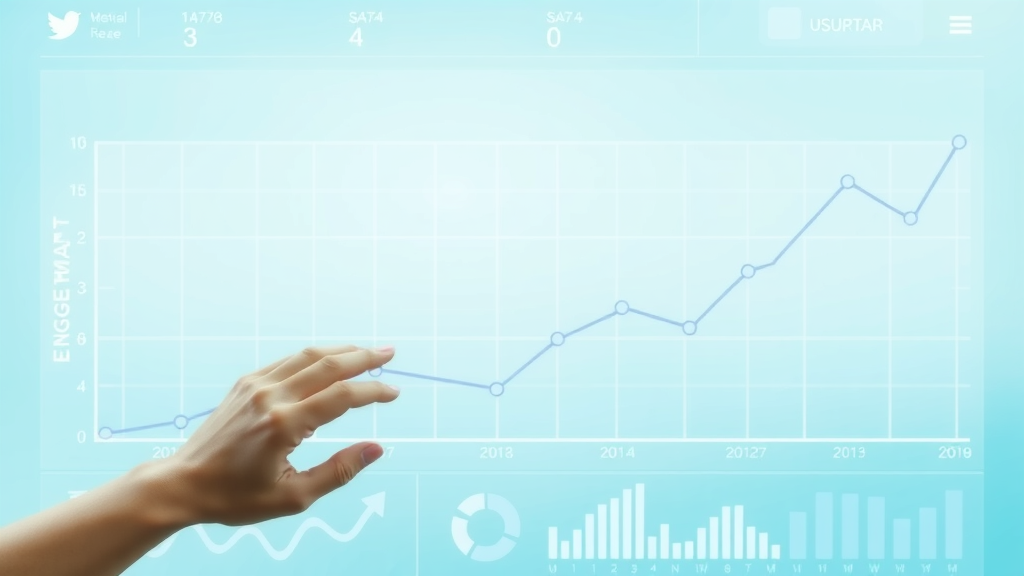Did you know that 84% of marketers believe social media analytics has a direct impact on business growth? If you’re not leveraging analytics tools to uncover the patterns behind every post, comment, and click, you’re essentially making decisions in the dark. In this guide, we’ll break down exactly how social media analytics can fuel higher engagement, smarter strategies, and better results for your business. Get ready to dive beneath the surface and discover the data-driven secrets powering today’s most successful social media campaigns.
Unlocking the Power of Social Media Analytics for Business Growth
In today’s digital world, understanding and applying social media analytics is vital for driving business growth. These analytics tools allow businesses to track not just how many people see their content, but also who interacts with it, how they behave, and why certain posts perform better than others. Insights from social media analytics empower companies to fine-tune their media strategy , tailor messages to the target audience , and continually optimize campaigns across multiple social media channels .
For instance, a brand noticing a surge in engagement rates after shifting their content focus from static images to short videos can double down on video production. Similarly, analyzing which media platform channels bring the highest conversion rates helps narrow advertising investments to proven performers. When businesses harness robust analytics tool capabilities, they stay ahead of trends, outperform competitors, and transform raw media data into revenue and loyalty.

Social Media Analytics: Transforming Insights into Actionable Strategies
- 84% of marketers say social media analytics has a direct impact on business growth.
- Learn how top brands decode media analytics to outperform competitors.
- The value of actionable social media analytics in today’s digital landscape.
Key Takeaways: What You'll Learn About Social Media Analytics
- Understand the core principles and definitions of social media analytics
- Explore the main types and layers of media analytics
- Learn best practices for using analytics tools
- Discover actionable tips for improving media performance across platforms
Social Media Analytics Explained: What You Need to Know
Defining Social Media Analytics and Why It Matters
At its core, social media analytics is the process of gathering, examining, and making sense of data from various social media platforms . This process goes beyond tallying likes and shares; it encompasses understanding real-time trends, sentiment analysis, and competitor benchmarking. By breaking down the performance of each piece of content, marketers can discover which topics or media formats resonate, pinpoint optimal posting times, and identify the influencers that matter most to their niche.
What sets social media analytics apart is its capacity to connect isolated data points into strategic insights. Today’s top media analytics tools aggregate information from multiple channels, filter out irrelevant noise, and showcase actionable patterns in easy-to-read dashboards. As a result, brands get a clear picture of what’s driving engagement and what’s not—turning intuition into evidence-backed strategy. In a world where attention is fleeting, the difference between viral growth and digital obscurity often comes down to mastering your analytics tools.

How Leading Enterprises Use Social Media Analytics for Success
Major brands rely on sophisticated social media analytics tools to spot trends before they hit the mainstream. By continuously monitoring shifts in audience sentiment and campaign performance, these companies make agile decisions that keep their messaging sharp and relevant. For example, global coffee giant Starbucks used media analytics to recognize an opportunity for seasonal content, ultimately increasing engagement by 47% in one campaign cycle.
Small businesses can emulate these successes by consistently reviewing media reports and tracking key media metrics to benchmark their growth. Whether it’s identifying which media channel is best for product launches or determining which type of influencer partnership yields the highest click-through rates, actionable social media data is at the heart of every winning social media strategy . Implementing regular data reviews also ensures that marketing spend is allocated to the tactics that deliver the strongest returns.
"Without social media analytics, your online marketing is just guesswork." — Industry Expert
Exploring the Role of Media Analytics Across Platforms
Media Analytics on Major Social Media Platforms
- Facebook, Instagram, Twitter, LinkedIn — unique analytics challenges
- Media platform-specific metrics and insights
- Adapting strategies by social media channel
Each social media platform offers a distinct set of data points and analytic challenges. Facebook analytics focus on reach, reactions, and the interplay between paid and organic engagement. Instagram relies heavily on story interactions, hashtag performance, and follower growth, while Twitter analytics track retweets, mentions, and trending hashtags. LinkedIn is all about post visibility with professionals, click-through rates, and content engagement in niche industries.
Success means tailoring your analytics tool stack to capture the right metrics from each channel. Having a comprehensive understanding of media platform -specific metrics allows you to adapt content formats, posting schedules, and ad spend for each media channel . This platform-first mindset ensures that every piece of content is optimized for its intended audience, increasing the impact of your social campaigns. Integration across all social media channels builds a holistic understanding of your digital presence.

The Relationship Between Media Analytics and Media Marketing
Media analytics and media marketing are two sides of the same coin. Without robust analytics tools, media marketing campaigns become hopeful trials rather than strategic initiatives. The right media analytics tool empowers marketers to understand campaign results, identify what resonates with target audiences, and inform future digital marketing strategies.
By weaving data-driven insights into every aspect of your social media marketing , you refine your value proposition, optimize social ad spend, and build lasting relationships with your audience. Analytics tools also reveal the best-performing media platforms and optimal times for engagement, significantly improving media performance over time.
Integrating Media Analytic Tools with Google Analytics for Holistic Insights
For a true 360-degree view of performance, integrating dedicated media analytics tools with Google Analytics is essential. Google Analytics bridges the gap between what happens on social platforms and user behavior on your website, highlighting how social campaigns drive conversions, sign-ups, or sales. Together, these analytics tools deliver a seamless flow of insights, from channel engagement through to completed transactions.
Using UTM parameters and goal tracking in Google Analytics, marketers can align platform insights with broader business KPIs. This integration uncovers hidden relationships between social media data and on-site actions, helping optimize content for every stage of the user journey and proving the ROI of your media strategy .
Social Media Analytics Tool Selection: What to Look For
Top Criteria for Selecting the Right Analytics Tools
- Real-time vs. historical data access
- Cross-channel compatibility for social media analytics tools
- Ease of report generation and custom media reports
Choosing the right social media analytics tool is more than just picking the most popular platform; it requires a careful match to your business needs. Look for tools that provide both real-time insight and in-depth historical data analysis for benchmarking trends and performance. The ability for cross-channel data collection is crucial, allowing you to pull analytics from all major social media channels and media platforms into a unified dashboard.
Additionally, ease of generating customized media reports can be a major time-saver, making it simple to share insights with your team or stakeholders. Advanced analytics tools also offer automation options, helping you schedule recurring reports and set performance alerts, so you’re always on top of your campaigns without manual effort.
| Tool Name | Notable Features | Best For |
|---|---|---|
| Sprout Social | Cross-Platform Data | Comprehensive Analytics |
| Hootsuite | Social Listening | Campaign Tracking |
| Google Analytics | Traffic & Behavior | Website/Social Analysis |

Comparing Media Analytics Tools for Social Media Performance
Different social media analytics tools cater to different business use cases. Some excel in social listening and brand monitoring (like Hootsuite), while others shine in in-depth content performance analysis (such as Sprout Social) or website/social integration (like Google Analytics). Key factors to compare include pricing, data visualization quality, API support, and the ability to benchmark against industry averages.
Platforms that offer flexibility to track both core social media metrics and more advanced media data will empower your team to extract deeper insights. Whenever possible, test tools with trial access to ensure their dashboard and reporting match your team’s workflow for maximum impact.
Unlocking Advanced Social Media Analytics: Layer by Layer
Understanding the 4 Types of Social Media Analytics
- Descriptive
- Diagnostic
- Predictive
- Prescriptive
To unlock the true potential of your analytics, it’s important to understand the four main types of social media analytics :
- Descriptive Analytics: What happened? This layer tracks basic metrics like views, clicks, and shares to build a performance baseline.
- Diagnostic Analytics: Why did it happen? By drilling into detailed data, it reveals why certain posts outperformed others—was it the timing, content type, or audience segment?
- Predictive Analytics: What is likely to happen next? Leveraging trends, machine learning, and historical data, this layer forecasts future trends or campaign outcomes.
- Prescriptive Analytics: What action should we take? It goes beyond forecasting to recommend and even automate strategies for optimal engagement and conversions.
The 7 Layers of Social Media Analytics

- Data Collection
- Data Cleaning
- Data Integration
- Data Analysis
- Data Visualization
- Insight Extraction
- Strategy Implementation
Each layer of social media analytics is a critical step in the journey from raw numbers to impactful action. Begin by collecting data across multiple media platforms , then clean it by removing duplicates and errors. Next, integrate the data into a central dashboard, making cross-channel comparison possible. From there, conduct analysis to identify patterns, visualize findings for easy interpretation, extract key insights , and finally, use those insights to guide strategy implementation on each social media channel.
This layered approach ensures a comprehensive and actionable understanding of your social presence, removing guesswork and empowering decisions that power authentic business growth.
How Each Layer Impacts Media Performance
Each analytics layer builds value for overall media performance . Accurate data cleaning and integration are essential foundations; without them, even advanced analysis could be misleading. Effective data visualization and insight extraction ensure that important trends don’t go unnoticed in the sea of available media data . Finally, the real magic happens at the strategy implementation stage—where you translate insights into content optimization, paid campaign tweaks, or entirely new engagement tactics. Consistently working through all seven layers keeps your brand’s social efforts data-informed and future-ready.
Essential Metrics: Measuring Social Media Analytics Performance
Core Social Media Metrics to Track
- Engagement rate
- Reach & impressions
- Conversion rate
- Social share of voice
- Follower growth
- Channel-specific media metrics
Knowing which social media metrics truly matter is the first step to meaningful measurement. While vanity metrics like “likes” offer a surface-level view, savvy marketers focus on metrics that reveal the health of their media performance . Engagement rate demonstrates how actively your audience interacts with content, while reach and impressions show your true brand footprint. Tracking conversion rate provides insights into how well content drives actions like clicks, downloads, or purchases. Social share of voice measures your brand's presence relative to competitors, and follower growth signals long-term community expansion.
Don’t ignore channel-specific media metrics unique to platforms (e.g., video views on Instagram vs. retweets on Twitter). These deeper data points give clear feedback on what’s moving the needle for your campaign goals.

Using Social Media Data for Better Reports and Decisions
Turning complex social media data into actionable reports is what separates winning teams from the rest. With a well-crafted media report , you can showcase not only “what happened,” but also draw connections between campaign strategies and their tangible outcomes. Advanced reporting tools allow you to customize dashboards for every stakeholder, ensuring that each team member receives relevant KPIs tied to their role.
"Measuring what matters in social media analytics leads to long-term digital success."
Consistently leveraging high-quality social media report insights allows for data-driven decision-making. The right analytics tool can automate report generation, detect anomalies, and recommend adjustments—unleashing the true potential of your media marketing strategy.
Developing an Effective Social Media Analytics Strategy
Implementing the 50/30/20 Rule for Social Media

- 50% Content Curation
- 30% Brand Messaging
- 20% Engagement/Community
The 50/30/20 rule is a common content mix guideline that leverages analytics insights for maximum impact. Spend 50% of your post calendar on curated content that your audience finds valuable, positioning your brand as a thought leader. Dedicate 30% to direct brand messaging and promotion—just enough to drive sales or sign-ups without overwhelming your audience. The remaining 20% should focus on active engagement and fostering community through social listening, questions, and real-time interaction. Adopting this balanced approach, with continual tracking of engagement and conversion stats via your analytics tool, increases both reach and loyalty on your social media channels.
Setting Social Media Performance Targets
Establishing clear goals is fundamental for measuring success with social media analytics . Set specific, time-bound targets for each core metric—such as a 15% increase in engagement over the next quarter or a 20% higher conversion rate from Instagram posts. Your analytics tool should allow easy visual tracking toward these targets, alerting you to both wins and areas to improve. Connecting your performance objectives with ongoing analytics reporting keeps your team motivated and strategies result-oriented throughout every campaign cycle.
Utilizing Social Listening and Media Reports

Social listening is a vital component of your analytics strategy. By leveraging advanced analytics tools to track brand mentions, sentiment, and trending topics, you can identify not only what your audience says but also how they feel. This qualitative layer of media data is crucial for adjusting messaging, spotting crises early, and building a brand reputation anchored in genuine connection. Regular media reports summarize these findings, ensuring that rapid feedback translates into meaningful action on your chosen social media platforms.
Optimizing Strategies Using Analytics Tools Feedback
Analytics tools aren’t just for measuring—they’re for refining every step of your social media marketing. Smart use of feedback loops from your analytics platform allows you to test new content formats, adjust posting schedules, and experiment with influencer collaborations. Real-time analytics can highlight when a campaign is underperforming, so you can pivot quickly and maximize your media performance. Top-performing brands review social media analytics continuously, integrating both quantitative and qualitative feedback to build winning playbooks for future growth.
Beyond Basics: Predictive and Prescriptive Social Media Analytics
Harnessing AI and Machine Learning in Media Analytics

The new frontier in social media analytics is harnessing AI and machine learning to reveal hidden patterns and forecast what will capture your audience’s attention next. Modern analytics tools leverage AI to automate sentiment analysis, predict strong content themes, and even suggest optimal ad spend to match predicted conversion spikes. This new generation of data-driven solutions not only accelerates reporting but also minimizes human bias, delivering faster and more accurate recommendations for your social media strategy.
Leveraging Media Data for Future-proof Strategies
Looking forward, smart brands are combining predictive and prescriptive analytics with human creativity to build future-proof digital marketing strategies. By regularly analyzing and acting on granular media data , companies can identify upcoming trends, uncover untapped audience segments, and anticipate competitor moves before they happen. This proactive approach ensures your messaging remains relevant and powerful, helping you maintain a competitive edge in the fast-paced world of social media marketing.
Real-World Success Stories: Social Media Analytics in Action
Social Media Reports That Changed the Game
- How Starbucks increased engagement by 47% using media analytics tools
- A tech brand’s success with real-time analytics tool integration
Consider the case of Starbucks, which embraced social media analytics tools to track and optimize seasonal promotions. By analyzing customer feedback, trending flavors, and purchase data, Starbucks increased engagement by 47% for its fall campaign. Another notable example involves a global tech brand that integrated real-time analytics with their existing marketing software, enabling them to adapt campaign messaging on the fly and outperform competitors during a major product launch.
"Making decisions based on media analytics tools leads to competitive advantage."

These stories highlight the transformative impact of embracing analytics for smarter, data-driven choices at every level of digital engagement. Fast, accurate insights fuel breakthrough marketing wins and empower ongoing digital innovation.
Best Practices for Social Media Analytics Tools and Reporting
Creating Effective Social Media Reports for Stakeholders

Effective social media reports go beyond raw numbers. They interpret trends, connect results to business objectives, and present insights in clear, impactful visuals. Start by outlining the key questions your stakeholders care about—whether it’s ROI, audience growth, or campaign performance. Use a mix of charts, graphs, and commentary to tell a “story” that supports decision-making. The best analytics tool platforms allow you to generate both detailed and high-level summaries, enabling every stakeholder to see the value of social media marketing at a glance.
Choosing Between Media Analytics Tools for Team Collaboration
When collaborating across marketing, sales, and executive teams, select analytics tools that facilitate real-time sharing, annotation, and commenting within dashboards. Tools that integrate with workflow management apps (like Trello or Slack) improve cross-functional action and ensure that data-driven conclusions feed back into daily operations. Custom user permissions within these tools help maintain data privacy and workplace efficiency.
People Also Ask: Answering Top Social Media Analytics Questions
What is meant by social media analytics?
Social media analytics refers to the process of collecting, analyzing, and interpreting data from social media platforms to inform business decisions, track performance, and optimize marketing strategies. It provides actionable insights that help brands understand what resonates with their audience and how to improve overall media performance.
What is the 50/30/20 rule for social media?
This rule suggests your content mix should be 50% curated content from reputable sources, 30% original brand messaging, and 20% direct engagement or community interaction. Following this mix keeps your audience informed, connected, and engaged, while maximizing your social media performance through a well-rounded social media strategy .
What are the four types of social media analytics?
The four types are: Descriptive analytics (what happened), Diagnostic analytics (why it happened), Predictive analytics (what will happen), and Prescriptive analytics (recommended actions to take). Each type builds on the last to transform data into actionable strategies.
What are the 7 layers of social media analytics?
These layers are: Data Collection, Data Cleaning, Data Integration, Data Analysis, Data Visualization, Insight Extraction, and Strategy Implementation. Together, they provide a roadmap from gathering raw media data to executing optimized marketing strategies based on solid insights.
Coming Soon: Watch our in-depth guide on leveraging analytics tools for campaign optimization and real-time decision making.
Stay tuned for our expert walkthrough comparing leading media analytics tool platforms, showcasing key features and best-fit scenarios for your business.
Don’t miss: Our video tutorial on building compelling reports that drive stakeholder buy-in and campaign improvements using integrated analytics tools.
Frequently Asked Questions About Social Media Analytics
- How often should I review media analytics data? It’s best to review core analytics at least weekly and run in-depth media reports monthly. More frequent checks may be needed during active campaigns or rapid market changes.
- What are common mistakes in social media analytics? Relying too heavily on vanity metrics, ignoring qualitative data, or failing to act on insights from the analytics tool are all common pitfalls. Regularly update your reporting strategy to avoid these issues.
- Which analytics tools are best for small businesses? Many small businesses succeed with Hootsuite (for social listening and scheduling), Sprout Social (for comprehensive reporting), and Google Analytics (for connecting social activity to website results).
- Can media analytics improve influencer marketing outcomes? Absolutely. By using analytics tools to track engagement, reach, and conversions, businesses can measure the real ROI of influencer partnerships and optimize future campaigns for better results.
Take the Next Step: Elevate Your Social Media Performance With Advanced Analytics
- Put insights into practice today with the right social media analytics tool
- Strengthen your brand’s digital presence with ongoing media analytics
- Begin optimizing every campaign for measurable, lasting results
Start leveraging data-driven social media analytics now to accelerate your growth, competition, and campaign success. The future belongs to brands that quantify, analyze, and optimize every post.
Sources
- Sprout Social – https://sproutsocial.com/insights/social-media-analytics/
- Hootsuite – https://hootsuite.com/resources/social-media-analytics
- Buffer – https://buffer.com/library/social-media-analytics/
- Social Media Examiner – https://www.socialmediaexaminer.com/social-media-analytics-how-to-improve-your-marketing/
To deepen your understanding of social media analytics and enhance your marketing strategies, consider exploring the following resources:
-
“Social Media Analytics Guide for Brands and Marketing Teams” : This comprehensive guide delves into various types of social media analytics, including performance tracking, competitive analysis, and social listening. It offers actionable insights to help you create data-driven marketing strategies. ( semrush.com )
-
“Social Media Analytics: Learn How It Works & Grows Your Brand” : This resource provides practical approaches to effectively utilize social media analytics tools. It emphasizes setting clear goals, identifying trends over time, and refining strategies regularly to optimize your social media efforts. ( coschedule.com )
By engaging with these materials, you’ll gain valuable insights into leveraging social media analytics to drive business growth and improve your marketing campaigns.
 Add Row
Add Row  Add
Add 




Write A Comment